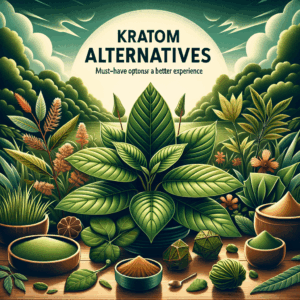
Kratom Drug Interactions: Must-Have Safety Tips
- Understanding Kratom and Its Uses
- What is Kratom?
- How Does Kratom Work?
- The Risks of Kratom Interactions
- Common Drug Interactions
- Risk Factors for Severe Interactions
- Safety Tips for Using Kratom
- Start Low and Go Slow
- Consult Your Healthcare Provider
- Avoid Mixing with Other Substances
- Monitor Your Body’s Response
- Potential Side Effects of Kratom
- Understanding Kratom Legality and Quality Control
- The Importance of Quality Control
- Integrating Kratom into a Holistic Approach
- Lifestyle Considerations
- Alternative Remedies
- Conclusion: Making Informed Choices
- FAQs
- References
Understanding Kratom and Its Uses

Kratom, or Mitragyna speciosa, originates from Southeast Asia. People have used it traditionally for centuries, primarily for its stimulant and sedative effects. Users consume kratom for various reasons, including pain relief, increased energy, and enhanced mood. Yet, like any substance, kratom comes with risks, particularly when mixed with other drugs or supplements.
Many of us might think of kratom as harmless since it’s derived from a plant. However, its interactions can lead to severe side effects. As kratom gains popularity, understanding its effects and potential interactions becomes crucial for safety.
What is Kratom?
Kratom is a tree native to the tropical regions of Southeast Asia. People often chew its leaves, brew them into tea, or take them in capsule form. Its primary active compounds, mitragynine and 7-hydroxymitragynine, interact with opioid receptors in the brain.
Many users report feelings of euphoria, pain relief, and increased focus. However, its stimulant effects can turn to sedation at higher doses. Understanding these effects is essential for anyone considering kratom use, especially in light of its interactions with other substances.
How Does Kratom Work?
Kratom interacts with opioid receptors in the brain. When activated, these receptors influence pain perception, mood, and behavior. Users often experience a blend of stimulant and sedative effects depending on the dose:
– Low Doses (1-5 grams): Users often feel increased energy and alertness.
– Moderate Doses (5-15 grams): Users may experience pain relief and mood enhancement.
– High Doses (15 grams and above): Effects may shift toward sedation and relaxation.
Despite its potential benefits, many people overlook its interactions with other substances, which can heighten risks and complicate effects.
The Risks of Kratom Interactions
Understanding the risks of kratom interactions can help users make informed decisions. Many substances can interact negatively with kratom, leading to unwanted side effects. It’s essential to recognize these interactions to avoid potential harm.
Common Drug Interactions
Kratom can interact with various medications and supplements. Here’s a quick look at some common interactions:
| Substance | Type of Interaction |
|———————–|——————————————————–|
| Alcohol | Increased sedation and risk of respiratory depression. |
| Benzodiazepines | Heightened sedation, risk of overdose. |
| Opioids | Potent pain relief but increased risk of side effects. |
| SSRIs/SNRIs | Potential for serotonin syndrome. |
| Caffeine | Increased heart rate and anxiety. |
| Antihistamines | Enhanced sedative effects. |
This table illustrates the common interactions users should be aware of when considering kratom use. The potential for these combinations to magnify side effects poses serious risks.
Risk Factors for Severe Interactions
Certain factors can increase the risk of negative interactions. Users should consider:
– Existing Health Conditions: Conditions like liver or kidney disease can affect drug metabolism, increasing the risk of side effects.
– Multiple Medications: Taking several medications can complicate interactions, as more substances increase the potential for adverse effects.
– Dose Size of Kratom: Larger doses can amplify effects and risks, particularly when combined with other substances.
Being aware of these risk factors is essential for safe kratom use.
Safety Tips for Using Kratom
If you decide to use kratom, implementing safety measures is critical. Here are several key tips:
Start Low and Go Slow
Starting with a low dose helps gauge your body’s reaction to kratom. Gradually increasing the dose allows you to find the right balance. This method reduces the risk of overwhelming side effects, especially if you’re combining kratom with other substances.
Consult Your Healthcare Provider
Always consult a healthcare provider before starting any new supplement. This is especially important if you’re taking prescription or over-the-counter medications. A healthcare professional can offer personalized advice based on your health history and current medications.
Avoid Mixing with Other Substances
Minimize the use of other substances while using kratom. Mixing it with alcohol, opioids, or sedatives significantly increases the risks associated with adverse effects. Sticking to kratom alone, especially at first, can help you understand its effects on your body better.
Monitor Your Body’s Response
Pay close attention to how your body responds to kratom. If you experience unwanted side effects, take note of them. Consider reducing your dosage or discontinuing use entirely if symptoms persist.
Potential Side Effects of Kratom
Understanding the potential side effects of kratom is essential. While many users report positive effects, some may experience negative outcomes. Here’s a list of common side effects:
– Nausea: Some users report feeling nauseous after taking kratom. This side effect is more common at higher doses.
– Constipation: Kratom can slow gastrointestinal motility, leading to constipation.
– Dizziness: Users may feel lightheaded or dizzy, especially at higher doses.
– Increased Heart Rate: Some users may experience palpitations or a racing heart.
– Dry Mouth: A common complaint, users often find they need to drink more water.
– Fatigue: Increased fatigue or sedation can occur, particularly with higher doses.
This list highlights the importance of understanding how your body reacts to kratom.
Understanding Kratom Legality and Quality Control
Kratom’s legal status varies by region. In some places, it remains legal and unregulated, while in others, it faces restrictions. Understanding the legal status of kratom in your area is essential before purchasing or using it.
The Importance of Quality Control
Kratom quality can vary significantly among vendors. Some crucial points to remember:
– Source: Choose vendors that provide clear information about their sourcing and processing practices.
– Laboratory Testing: Look for vendors who test their products for purity and contamination. Independent lab results can provide reassurance about product quality.
– Customer Reviews: Reading reviews can give insight into a vendor’s reputation and the quality of their kratom.
Prioritizing high-quality kratom can reduce the risk of negative interactions.
Integrating Kratom into a Holistic Approach
If you consider using kratom, integrating it into a broader approach to health is beneficial. Here are a few tips to keep in mind:
Lifestyle Considerations
– Hydration: Drinking enough water supports overall health and helps counteract kratom’s potential side effects, including dry mouth.
– Nutrition: Eating a balanced diet can improve your overall well-being and support your body in processing substances like kratom.
– Exercise: Regular physical activity can enhance mood and energy levels, complementing the effects of kratom.
Alternative Remedies
Consider other natural remedies for pain or mood support. Herbs like turmeric, ginger, and willow bark have been studied for their health benefits and might serve as alternatives.
Conclusion: Making Informed Choices
Using kratom can come with rewards and risks. Understanding its interactions and potential side effects helps you make informed choices. Always prioritize your safety, consult professionals when needed, and remain vigilant about your body’s response.
While kratom may offer benefits, the importance of awareness cannot be overstated. By following the safety tips outlined here and prioritizing high-quality products, you can minimize risks.
Navigating the world of kratom requires open communication with healthcare providers and a commitment to self-care. With the right approach, kratom may complement your wellness journey while keeping you safe.
FAQs
1. Is kratom legal in all states?
No, kratom legality varies by state. Some states have banned it, while others allow its use. Always check local laws.
2. Can kratom help with anxiety?
Some users report reduced anxiety levels, but results vary. Consult a healthcare provider for personalized advice.
3. What are the withdrawal symptoms of kratom?
Withdrawal symptoms may include irritability, nausea, and cravings. Everyone’s experience is different.
4. How long do the effects of kratom last?
Effects generally last between 2 to 6 hours, depending on the dose and individual metabolism.
5. Can I take kratom daily?
While some users do, daily use may lead to dependence. Moderation and breaks are advisable.
6. What is the best way to consume kratom?
Kratom can be consumed in various forms, including tea, capsules, and powders. The best method depends on personal preference.
7. What should I do if I experience side effects?
If you experience side effects, stop taking kratom and consult a healthcare provider immediately.
8. Does kratom show up on drug tests?
Standard drug tests usually do not screen for kratom. However, specific tests may detect it.
9. Can I mix kratom with coffee?
Mixing kratom with caffeine can increase jitteriness or anxiety. It’s best to consume with caution.
10. Where can I buy quality kratom?
Purchase kratom from reputable vendors that provide lab testing and transparent sourcing practices.
References
– Kratom: What You Need to Know
– Kratom Interactions with Other Drugs
– Understanding the Risks of Kratom
– Kratom: Benefits, Side Effects, and Risks
– FDA and Kratom: What You Should Know


